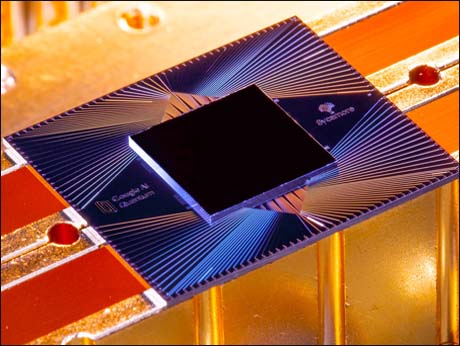
By Anand Parthasarathy
December 20 2019: For almost a decade, scientists have been touting the revolutionary nature of the technology – and the unimaginably high speeds of computation that it offers. Yet research worldwide has remained just that, with no visibility of practical realization. End October changed all that.
In an announcement by its India-born CEO Sundar Pichai, Google claimed that it’s team of researchers had achieved a big breakthrough in quantum computing known as quantum supremacy. The term meant that they had used a quantum computer to solve a problem that would take a classical computer an impractically long amount of time. They had successfully performed a test computation in just 200 seconds that would have taken the best known algorithms in the most powerful supercomputers thousands of years to accomplish, Pichai reported.
As the world of high performance computing struggled to grasp the magnitude of this claimed achievement, the journal Nature published a paper jointly authored by 77 engineers titled “Quantum supremacy using a programmable superconducting processor”, laying out the details of the computation performed by their quantum computer, with a explicit claim that the best supercomputer today using conventional technology would take 10,000 years to complete the same calculation. To do this computation, the Google team designed a quantum processor named ‘Sycamore’ which consists of a two-dimensional array of 54 qubits – the quantum equivalent of the bits – ones and zeroes -- that we are used to in all digital calculations. ( see Image of the Day: Bits versus Qubits).
_________________________________________________________
The fuller version of this article appears in the December 2019
issue of the monthly journal, Science Reporter
http://nopr.niscair.res.in/handle/123456789/52697
__________________________________________________________
Pulses of microwaves cause the qubits to vibrate and electromagnetic pulses at a different frequency cause the bit flips. There is little to see outside – except a large touch screen displaying lines of waveforms that correspond to the functions being performed on the qubits.
Another portion of the screen displays what is happening to each qubit, as it oscillates between 1 and 0. Unlike the digital ones and zeroes, these can be any value in between. This is known as “superposition” and is at the core of how qubits are infinitely superior to digital bits: like a juggler in the circus, juggling multiple balls, they can do more than on computation at a time… resulting in the mind boggling computation speeds of quantum computers.
The conditions described above, under which quantum computers can work are so stringent, that few organisations have been able to set them up. Even researchers may not be able to afford them. Which is why according to Gartner, a new service industry may emerge: Quantum Computing as a Service ( QCaaS) where academia or industry hoping to harness quantum computers, can ‘pay by use”.
Google’s audacious announcement that it has attained “quantum supremacy” has been received with skepticism in some quarters. The term quantum supremacy is a concept which was originally coined in 2012, by Caltech professor of theoretical physics John Preskill and means a quantum computer outperforms a classical computer and does something a classical supercomputer cannot do today.
Every digital device is a classical computer – from the first general purpose computer ENIAC, made in 1945, to your smart watch. The fastest computer in the world today, is the'Summit' also called OCLF-4, developed by IBM and installed at the Oak Ridge National Laboratory which in November 2018 performed 200 petaflops ( a peta flop is 1000 teraflops or 10 raised to the power 15 flops or floating point operations).
IBM has a major programme in Quantum Computing running – and was the first to challenge Google on its claim of quantum supremacy. In a blog published after Google’s 'Nature' paper was published. It claimed that even by a “conservative and worst-case estimate....an ideal simulation of the same task can be performed on a classical system in 2.5 days and with far greater fidelity”. Ten thousand years versus two-and-a-half days? No wonder IBM suggested that Google’s claim should be taken with a “with a large dose of skepticism.” The company goes on to suggest:
"By its strictest definition the goal has not been met......fundamentally, because quantum computers will never reign 'supreme' over classical computers, but will rather work in concert with them, since each have their unique strengths." It is also worth mentioning that while Google's Quantum computer demands extreme environmental conditions, it is economical when it comes to real estate. The IBM Summit machine occupies the space of 2 basketball courts.
The academic community is evenly divided between the positions taken by Google and IBM -- and while few actually question the magnitude of the Google Quantum achievement, some are skeptical about its practical and ubiquitous availability as a new tool of blazingly fast number crunching.
At Google though, there are no doubts: It has already signed up the first few customers -- automobile giants Volkswagen and Daimler -- and the US Department of Energy who expect to be harnessing the Quantum Computer as early as next year, albeit as a cloud based service-on-demand.
The potential applications of quantum computing straddle the gamut of applications: from biochemistry and drug discovery to timely brain tumour detection in humans to developing new non corrosive paints to predicting market instability. Common to all such applications is one factor: Quantum Computers will perform the required calculations in seconds rather than weeks. How far are we from being able to address such tasks at quantum speeds? That is still a guessing game. But Google is very clear: "We are only one algorithm away from valuable near-term applications", its research paper claims. Perhaps it is finally time to say 'hello!' to the brave new world of quantum computers.